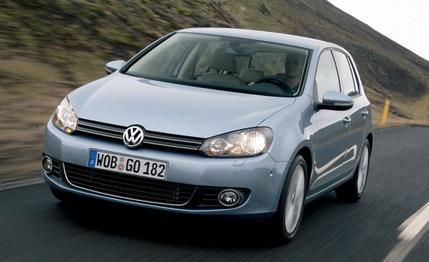
 First Drive Review
First Drive Review
You bet we love diesels. Modern diesels are clean, have gobs of ground-pounding torque, and get fuel mileage that shames pretty much any comparably sized gas-fired engine. So when we were given the opportunity to get behind the wheel of a Golf VI TDI in Italy before it goes on sale in America, we jumped at the chance. (Volkswagen loves diesels, too. The lower price of the fuel this year combined with the public’s desire to get more bang for its fuel buck has U.S. VW oil-burner sales soaring. Last month, diesel fueled some 26 percent of all Volkswagens sold, including 81 percent of Jetta SportWagen sales.)


The Golf is offered with several diesel engines in Europe—the top spec is the hot, GTI-inspired GTD—but the U.S. will get just one: a 140-hp, 2.0-liter turbo four-banger putting out 236 lb-ft of torque. That was the engine found under the hood of our test car, and it’s the same one already available to U.S. buyers in the Jetta TDI. In the Jetta, the engine has proven remarkably, well, unremarkable, and that’s a good thing. Excepting the elevated fuel-economy numbers in the gauge cluster—the Jetta TDI is EPA-rated for 31 mpg city and 41 mpg highway with a manual—most drivers wouldn’t even notice they’re driving a diesel. The car is quiet and utterly normal to live with. The Golf TDI we drove? It was exactly like that.
We appreciated the TDI’s eagerness to rev and punchiness off the line, especially in the clogged and narrow Roman and Florentine streets we drove during our test. Launching the car using the six-speed manual (we’ll also get a DSG dual-clutch automated manual option) was easy if you wanted to get off quickly; just stomp on the accelerator and rapidly let the clutch out. The steering was a tad light, but it was fantastically accurate. The firm suspension could get a bit harsh over broken pavement, but it also kept the car flat in corners and, combined with the steering, made quick work of the twisted Umbrian roads that connect Florence and Rome. Traversing the autostrada at triple digits was similarly drama-free.
A More-Grown-Up Golf
We also appreciated the Golf VI’s newfound maturity. Although it’s essentially the same as the outgoing Golf/Rabbit underneath—and drives almost identically—Volkswagen has thoroughly revised the interior and exterior. As we’ve written before, the quality and design of the Golf VI’s interior is far and away better than the cabin of the previous-gen car, and that wasn’t a hobo tent or anything. The new sheetmetal looks grown-up and classy, and we particularly like the clear strip at the bottom of the taillamps and the new face, which finally distances VW’s look from that of its upmarket Audi subsidiary. The end result is a car that’s modern, refined, and very adult. Of course, our black-over-black tester should have come across that way—it cost the equivalent of nearly 50 grand.
But wait a minute and pull your tongue out of your throat. You see, although that price is completely insane for what is a compact hatch in America, the Golf is a full-size family car on the Continent (ours was often the largest car we would see for an hour at a time), and we were driving one of the nicest examples ever constructed. As VW’s most important car in Europe, the Golf is offered there with an absolute bevy of luxury options, and our tester had most of them: heated leather sport seats; a touch-screen nav system; multimedia jacks; heated, folding mirrors; parallel-parking sensors; rear-assist sensors; 18-inch Vancouver-style wheels (a two-inch upgrade from the less-ritzy-sounding Cleveland wheel); and more. It also was the top-spec Highline model, which in and of itself includes stuff like dual-zone automatic climate control, an upgraded stereo, and tasteful chrome accents in the cabin. The Golf is available in Europe with 4MOTION all-wheel drive, adaptive cruise control, an auto-parking feature, and a three-way adaptable chassis system to adjust shock stiffness and steering assist. Don’t expect much of the preceding to be available on U.S.-spec models.
The Golf VI goes on sale in the U.S. this October, but you won’t be able to purchase a TDI until December, at which point we’re told to expect that it will carry a premium slightly higher than the one carried by the Jetta TDI. That car commands about $2000 more than a comparable gas-fired Jetta, so figure to pay in the low-to-mid-20s for an entry-level Golf TDI. A $1300 government tax credit is currently available on the Jetta diesel, and the incentive should be available to diesel Golf adopters, too. Should the first U.S. Golf TDI drive anything like this Euro car—and there’s zero reason to think it wouldn’t—we just may be filling out some adoption paperwork ourselves.